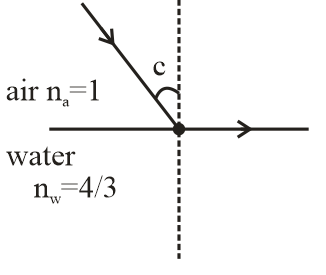
Answer
462.3k+ views
Hint: Critical angle is defined as the angle of incidence beyond which rays of light passing through a denser medium to the surface of a less dense medium are no longer refracted but totally reflected and numerically it is given as $c = {\sin ^{ - 1}}\left( {\dfrac{{{n_r}}}{{{n_i}}}} \right)$
Where
c $ = $ critical angle
${n_r} = $ refractive index of medium where ray will be refracted
${n_i} = $ refractive index of medium where ray is incident
Complete step by step answer:
The absolute refractive index is defined as the ratio of the speed of light in vacuum and in the given medium. It should never be less than 1.
Given that the absolute refractive index of water is $ = \dfrac{4}{3}$.
Now we have to find critical angle
Critical angle is the angle of incidence beyond which the total internal reflection of light occurs.
Total internal reflection is a phenomenon in which the incident ray becomes completely reflected

In the diagram, we can easily see that the ray becomes completely reflected. So, the critical angle is given as
$\sin c = \dfrac{{{n_r}}}{{{n_i}}}$
Here ${n_r} = {n_w} = \dfrac{4}{3}$
${n_i} = {n_a} = 1$
So, $\sin c = \dfrac{1}{{4/3}} = \dfrac{3}{4}$
$c = {\sin ^1}\left( {\dfrac{3}{4}} \right)$
$c = 48.5$
Note:
Total internal reflection occurs only when light is travelling from rarer medium to denser medium.
When light travels from rarer to denser medium then it is moving far away from normal.
When light travels from denser to rarer medium then it is moving towards normal.
Where
c $ = $ critical angle
${n_r} = $ refractive index of medium where ray will be refracted
${n_i} = $ refractive index of medium where ray is incident
Complete step by step answer:
The absolute refractive index is defined as the ratio of the speed of light in vacuum and in the given medium. It should never be less than 1.
Given that the absolute refractive index of water is $ = \dfrac{4}{3}$.
Now we have to find critical angle
Critical angle is the angle of incidence beyond which the total internal reflection of light occurs.
Total internal reflection is a phenomenon in which the incident ray becomes completely reflected

In the diagram, we can easily see that the ray becomes completely reflected. So, the critical angle is given as
$\sin c = \dfrac{{{n_r}}}{{{n_i}}}$
Here ${n_r} = {n_w} = \dfrac{4}{3}$
${n_i} = {n_a} = 1$
So, $\sin c = \dfrac{1}{{4/3}} = \dfrac{3}{4}$
$c = {\sin ^1}\left( {\dfrac{3}{4}} \right)$
$c = 48.5$
Note:
Total internal reflection occurs only when light is travelling from rarer medium to denser medium.
When light travels from rarer to denser medium then it is moving far away from normal.
When light travels from denser to rarer medium then it is moving towards normal.
Recently Updated Pages
10 Examples of Evaporation in Daily Life with Explanations

10 Examples of Diffusion in Everyday Life

1 g of dry green algae absorb 47 times 10 3 moles of class 11 chemistry CBSE

What is the meaning of celestial class 10 social science CBSE

What causes groundwater depletion How can it be re class 10 chemistry CBSE

Under which different types can the following changes class 10 physics CBSE

Trending doubts
Fill the blanks with the suitable prepositions 1 The class 9 english CBSE

Which are the Top 10 Largest Countries of the World?

How do you graph the function fx 4x class 9 maths CBSE

Who was the leader of the Bolshevik Party A Leon Trotsky class 9 social science CBSE

The Equation xxx + 2 is Satisfied when x is Equal to Class 10 Maths

Differentiate between homogeneous and heterogeneous class 12 chemistry CBSE

Difference between Prokaryotic cell and Eukaryotic class 11 biology CBSE

Which is the largest saltwater lake in India A Chilika class 8 social science CBSE

Ghatikas during the period of Satavahanas were aHospitals class 6 social science CBSE




